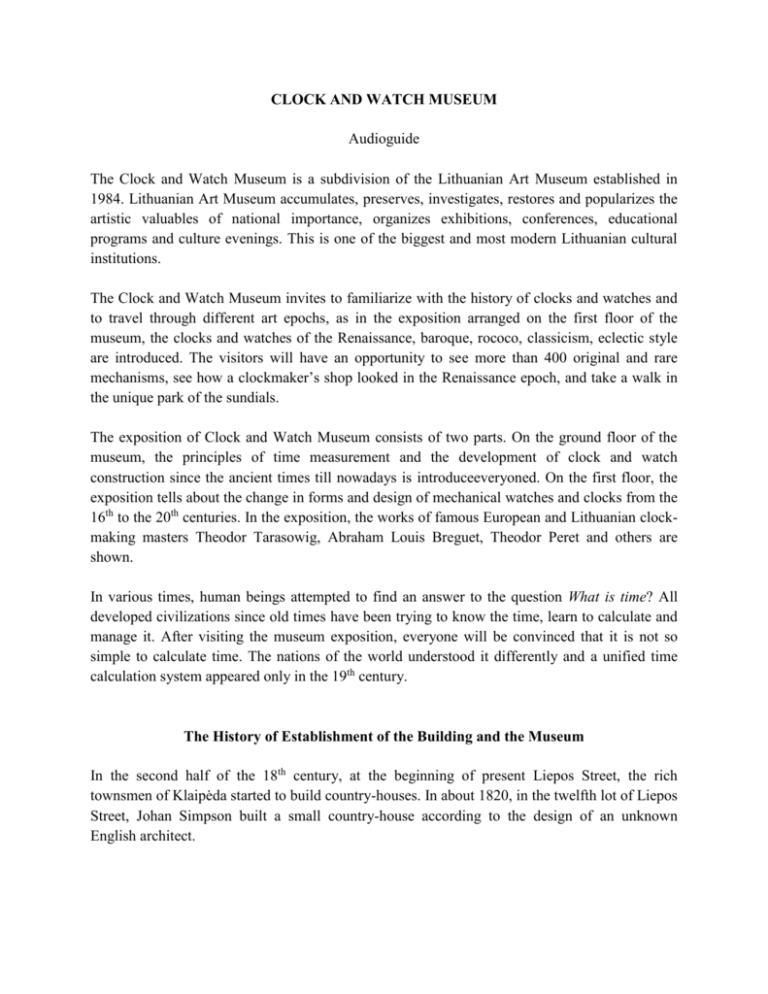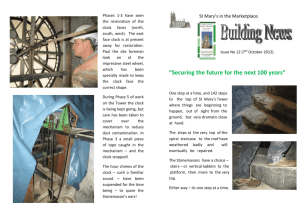History of the clock structures from the ancient times till the
advertisement

CLOCK AND WATCH MUSEUM Audioguide The Clock and Watch Museum is a subdivision of the Lithuanian Art Museum established in 1984. Lithuanian Art Museum accumulates, preserves, investigates, restores and popularizes the artistic valuables of national importance, organizes exhibitions, conferences, educational programs and culture evenings. This is one of the biggest and most modern Lithuanian cultural institutions. The Clock and Watch Museum invites to familiarize with the history of clocks and watches and to travel through different art epochs, as in the exposition arranged on the first floor of the museum, the clocks and watches of the Renaissance, baroque, rococo, classicism, eclectic style are introduced. The visitors will have an opportunity to see more than 400 original and rare mechanisms, see how a clockmaker’s shop looked in the Renaissance epoch, and take a walk in the unique park of the sundials. The exposition of Clock and Watch Museum consists of two parts. On the ground floor of the museum, the principles of time measurement and the development of clock and watch construction since the ancient times till nowadays is introduceeveryoned. On the first floor, the exposition tells about the change in forms and design of mechanical watches and clocks from the 16th to the 20th centuries. In the exposition, the works of famous European and Lithuanian clockmaking masters Theodor Tarasowig, Abraham Louis Breguet, Theodor Peret and others are shown. In various times, human beings attempted to find an answer to the question What is time? All developed civilizations since old times have been trying to know the time, learn to calculate and manage it. After visiting the museum exposition, everyone will be convinced that it is not so simple to calculate time. The nations of the world understood it differently and a unified time calculation system appeared only in the 19th century. The History of Establishment of the Building and the Museum In the second half of the 18th century, at the beginning of present Liepos Street, the rich townsmen of Klaipėda started to build country-houses. In about 1820, in the twelfth lot of Liepos Street, Johan Simpson built a small country-house according to the design of an unknown English architect. The building used to belong to different owners. At the beginning of the 20th century, here the Agricultural Bank was acting, and after World War II, Klaipėda Pioneer and Schoolchildren House was moved to this country-house. 1978 is considered to be the beginning of the activity of Clock and Watch Museum, when the first exhibition of ancient clocks and watches was opened in Klaipėda Picture Galery. In it, the exhibits of the city’s collectors Vytautas Jakelaitis, Dionyzas Varkalys, Stasys Gadeikis, Liudas Mažūnas were presented. The exhibition aroused big interest among Klaipėda residents and city guests, therefore, in 1979, the Lithuanian Art Museum Clock and Watch Department was established which after five years was reorganized to the Clock and Watch Museum. (1) The Calendar of a Log Form At the beginning of the exposition, the visitors of the museum can familiarize with the first primitive calendars, also with the history of sundials and water clocks. When and how did the first time measurement devices form? What was special about them? The first time measurement device invented by people was a calendar. There are three sorts of primitive calendars. These are moon, moon-sun and sun calendars. The first Moon calendars were the moon phases, simply marked on mammoth bones. Their use was started approximately 35 thousand years ago. The first device of measurement of time in this excursion is a primitive calendar of a log form. That is a model-reconstruction. In the log, 12 banks have been made which indicate months. In the banks, the markings of days are cut. Every day, people by transferring a wooden brad in the banks used to count days. (2) The Reconstruction of an Egyptian Sundial of Shadow Length The first sundials were invented in Egypt in the 3rd millennium BC. These are devices indicating the real time of the place where they are standing. While performing the archaeological digs in Egypt, the description of this sundial was found. The sundial consists of two straight sticks exactly oriented in the directions of north and south and west and east. The first stick is a hand, called style. By the position of its shadow in respect of the holes drilled in the second stick, time was measured. (3) The Sundial of a Shadow Direction Sundials of shadow direction appeared in Babylon and Egypt approximately in 3rd-2nd millenniums BC. With the help of these devices, time was measured by shadow direction on a horizontal or vertical plane. For that aim, vertical poles standing on an even place were employed, their shadow as the sun travelled in the celestial sphere used to turn as if a hand around their basis. At that time, high obelisks were used as styles. Gradually, different extremely sophisticated sundials appeared. Even a sundial – alarm clock was designed. The lens of this sundial of shadow direction used to direct the sun rays to one point of the little cannon and at the fixed time, most often at noon, used to ignite the gun-powder. Then, the little cannon was fired declaring the noon. This unconventional mechanism was produced in Germany in the 19th century. (4) The Sundial with Five Styles This is a copy of a sundial with five styles produced in Vilnius in 1781. The author of the original is the clockmaker Ignotas Manuviras of the 18th century. In the quadrant of the device, even four additional scales are engraved. Two of them are of the form of a spiral and are aimed for measurement of night time according to the shadow of decrescent or waxing moon. The other two scales used to show the hours of ancient Jews and Babylonia inhabitants. The fifth style placed in the centre was aimed for the measurement of local sun time. We do not have the information on when the first sundials were arranged in Lithuania. One of the oldest sundials remaining till nowadays was arranged in Šiauliai – on the southern wall of St. Peter and Paul’s Church in 1682. (5) The Out-Flowing Water Clock “Clepsidra” The out-flowing water clocks were used for measuring the time during which the water at a stretch outflows from a vessel of a certain capacity. They were invented in the 2nd millennium BC. Later, the Greeks started to use them and called them “Clepsidra”, which in Latint means “to steal water”. Unlike the sundial, the water clock could operate both in the day-time and at night and in any weather. The vessel filled with water used to be inserted in a support. The time was calculated according to the duration of time during which the water runs out of the vessel. (6) A Fire Clock-Wick With the help of fire clocks, the time is calculated according to the duration during which the wick, candle or oil burns to a crisp. The fire clock-wick consists of a smouldering wick placed on the bottom of a wooden tray. On the tray, in the necessary place, a thread is hung to which two metal balls are fastened. When the wick burns to the thread, it burns out and the balls fall on a little plate placed on the bottom signaling that the intended time period has passed. This device was used in China in the 14th-19th centuries. (7) The Sandglass Sandglasses measure time duration during which the sand runs out from one glass vessel into the other. Greek scientist Archimedes was the first to describe the sandglasses in the 3 rd century BC. In Europe, they spread in the 15th century when the production of transparent glass was started. The glassblowers used to blow a smooth hermetic vessel; they used to pour crushed sieved marble, granulated tin, lead, eggshells, mustard or millet seeds into it. The sandglass of 5 minutes was produced in the 19th century in Eastern Prussia and aimed for measuring the duration of boiling of eggs. That is a sandglass of the grandfather of museologist Roza Šikšnienė, he lived in the district of Šilokarčema of that time, at present Šilutė, in East Prussia. Most of the residents of that land were using such devices. (8) The Spring-Loaded Mechanical Clock In the third hall, the history of development of mechanical clocks is introduced. The first mechanical clocks were invented at the end of the 13th - first half of the 14th centuries. They were arranged in the towers of churches, town halls, palaces and aimed for public use. In Lithuania, in the 17th century, the clockmaker Aleksandras Helmanas created a mechanism for Vilnius Tower clock. One of the most important early engines of mechanical clocks was weights. Another significant engine invented in the 15th century in Italy was the mainspring. The first springs coiled up of long steel bands were to be wound several times a day. At the beginning of the 16th century, German master Peter Henlein improved and reduced this device in such a way that the spring went into a box of 6 centimetre diameter and after winding used to operate for 40 hours. The spring-loaded mechanical clock exhibited in the glass-case was created according to the models of Peter Henlein. This is a mechanism of a clock for coach of “Junhans” firm. (9) The Clock of Conical Pendulum In the second half of the 17th century, after inventing a pendulum, the accuracy of a clock was improved by 100 times. From then, the measurement of time according to the periods of pendulum swing was started. We can find a clock with a pendulum already in the graphics of Leonardo da Vinci, however, the biggest merit in inventing such a clock is attributed to Italian scientist Galileo, who prepared the design of the first pendulum clock in 1636. The first running clock of this type was produced by famous Dutch physicist, mathematician and astronomer Christiaan Huygens in 1657. He thought of a regulator the pendulum of which would not swing, but would turn in an arc at a horizontal plane. The clock of a conical pendulum marked by number nine was produced at the beginning of the 20th century in Germany, at the Gustav Becker firm. (10) A Pendulum Tower Clock That is a restored clock of the old Klaipėda Fire-station tower. It was made in 1856 at Refsehner shop in Berlin. The clock used to toll in the fire-station tower till 1979. When due to the pendulum the accuracy of the clocks had improved, they started to be used for scientific investigations and astronomic observations. However, these devices used to operate only in a stable position, which means hanging on a wall, placed on a table or on a floor, and they could not be carried or moved. It was necessary to create such a regulator of a mechanical clock which under any position of the clock would show the exact time. That was achieved when the regulator – balance of portable and stationary mechanical clocks was invented. (11) The Balance Clock This device was created at the end of the 19th century in Switzerland. The principle of its operation is the same as that of the pendulum one, but a balance clock shows time in any position. In the 18th-19th centuries, the balance clocks were improved. The use of a seconds hand was started in them. (12) The Mechanism of a Wall Clock with an Anchor The first and probably the most important improvement of the mechanism of operation of a pendulum clock was made in England: here, in 1670, William Clement built the first pendulum clock with the mechanism of an anchor. The device exhibited in the glass-case was created at the beginning of the 20th century in German Junhans firm. An anchor is an intermediary link which connects the pendulum with a gear and an engine. The anchor controlled by a pendulum maintains its fluctuations and performs the regulation of the motion wheel. The shorter the anchor acts on the pendulum, the more accurate is the clock. (13) The Clock Mechanism with Gears This device was created in Germany at the end of the 19th century. Gears appeared already in the first clocks of the 14th century; however, they acquired the present structure only in the 18th century. The gear counts the fluctuations of the clock regulator and by hands shows the results of counting on the face. (14) The Mechanism of a Carriage Clock with a Musical device The mechanism of a carriage clock with a musical device was created at the end of the 19th – beginning of the 20th century in Western Europe. In this device, the mechanism of sound indication is running. Such devices were already in the first tower clocks. In the 16th century, they were built-in in the table clocks and pocket watches as well. (15) The Table Clock with a Turning Bone Face This mechanism was produced at the beginning of the 20th century in Germany. In the 14th -15th centuries, certain tower clocks had faces without hands, while others had only one hour hand. In the 15th century, such devices were created, into which an immobile hour hand was installed as well as a rotating disc of the face. Minute hands were started to be used in the 17th century and after a hundred years, second hands were already built-in in the pocket watches as well. The decoration of faces depended on the fashions and domineering styles of that period. (16) The Pocket Watch with a Stopwatch A stopwatch is a mechanical watch aimed for measurement of short time intervals in seconds and their parts. It was invented at the end of the 19th century. The exhibited watch was produced at the end of the 19th – beginning of the 20th century at SANDOZ Company in Switzerland. This family enterprise was established by a Swiss Henry Sandoz in 1870. In it, the whole dynasty of famous European clockmakers was working. The exhibited device was produced by clockmaker Alfred Sandoz. (17) The Sea Chronometer One of the most important inventions in the history of clocks and watches was a sea chronometer. Very precise movable watches are called chronometers. The demand for such precise time measurement devices grew in the 16th century after navigation started to develop rapidly. At the beginning of the 18th century, the English Government allotted a big prize for an inventor of a precise balance clock-chronometer. In 1759, the prize was awarded to John Harrison who produced a watch complying with the indicated requirements. The chronometer introduced in the exposition was made in England, in the second half of the 19th century. Its creator was William White. (18) The Principle of Running of an Electromechanical Clock The first electronic clock was designed in France in 1919. Its authors were Felix Bloch and George Abraham. The mechanism of the device is periodically switched into the contact of an electric circuit, and it employs the power of the source for maintaining the pendulum swings and turning of hands. The face of the clock is exhibited in glass-case No. 34, and the mechanism in glass-case 34a. The face and mechanism are remotely connected. Several more faces can be connected to this clock mechanism. Such electromechanical devices were employed at the end of the 19th – 20th century when creating a unified time system. (19) The Pen with a Fitted Quartz Watch and a Liquid Crystal Face This watch was made in the 20th century in Japan. In 1955, scientists Nikolai Basov and Alexander Prokhorov from the Soviet Union and American Nobel Prize winner Charles Townes invented a quantum mechanical oscillator-maser, which determined coming of quantum clocks. A quantum or atomic clock is the most precise time measurement device. In these watches, the light oscillations which appear in atoms are counted. The preciseness of modern atomic clock with caesium atoms is an error of 1 second during 300 million years. In spite of this, the scientists are trying to create even more precise devices. (20) The Citizen Clock In the exposition, twenty four clocks produced by Citizen, a Japanese company, which was established in 1918, are shown. On them, the visitors can watch the time counting in all the 24 time- zones. The surface of the Earth is divided into twenty four hour zones. The zone time was introduced aiming to avoid different local time in close localities. Till the end of the 19th century, local times were used, and in 1884, during Washington International Conference, the system of zone time counting was introduced. (21) The Clock of Theodor Tarasowig The exposition on the first floor reflects the change in forms of clocks finish over different epochs. It is arranged in five halls. In every hall, the epoch style is reflected by both clocks design and the sets of furniture, paintings and the colour background of the pieces of the applied and decorative art. In the first hall, original clocks of the Renaissance style finish of the 16th-17th centuries are exhibited. Most often, they consisted of a basement, walls and a crowning part, decorated with engraved vegetal and animal ornaments, figure compositions and reliefs. The fact that in the faces of clocks of the Renaissance style only the hour hand was moving is interesting. The exhibited clock of the Renaissance style was produced in the 17th century. This exhibit is the centerpiece of the museum. Its author was a famous Lithuanian clockmaker Theodor Tarasowig. This is a bronze table clock with three stems of the form of a lion paw and a bell. In the upper box plane, a Vilnius picture is engraved. (22) The Set of Punches The clockmaker’s shop familiarizes the museum visitors with the ancient tools intended for clock and watch production, repair and finish of the 16th-19th centuries. In the centre of the exposition, a craftsman of the Renaissance epoch repairing an ancient clock in the light of candles is “lodged”. A universal setf punches was created in Boly, a German firm, in 1870. These instruments were necessary for performing accurate repair works on clocks and watches. In Europe, the profession of a clockmaker formed only in the 16th century, and till that time, the tower clocks were created by smiths, metalworkers and joiners. In the 16th century, the masters from France, Germany, England and Switzerland started to cluster into crafts. At that time, there was no distribution of labour and narrow specialization, so a clockmaker had to know both mechanics and the work of a metalworker and a jeweler. At that time, very expensive unitary clocks were produced which only the rich could acquire. In Lithuania, clockmaker craft appeared in the 18th century. (23) The Clock with a Console The luxurious and dynamic baroque style started to form at the end of the 16th century in Rome. In the 17th century, it developed and spread across the entire Europe. The clock with a console was produced in the 19th century in France. It is decorated with the bone of a tortoiseshell, bronze casting and brass plates. This furniture decoration technique, called “marquetry” by uniting the bone of tortoiseshell and brass plates, ebony and the expensive wood of other trees was refined by the painter-cabinet maker André Charles Boulle of the King of France Louis XIV palace, and his four sons. The encrusting of tortoiseshell is most probably chosen not accidentally. Since long time ago, the tortoise was the symbol of time and was related with wisdom, stability, longevity. (24) The Pocket Watch with a Chain In the exposition of the third hall, the clocks of rococo style predominate. An original collection of pocket watches of that period is exhibited. The masters reached the top of finish of these devices in the 18th century. At that time, the splendor of a watch could not be surpassed. Various expensive materials were employed so subtly that they made the man treat a watch not as a mechanism showing the time, but as a piece of art as well. Often, such splendid watch was forgiven for deviations from the indication of the exact time. The pocket watch with a chain was manufactured at the beginning of the 19th century in London. Its external lids are decorated with enamel miniatures, engraved and gilded. The chain is made of silver, decorated with a hand of mother-of-pearl and golden miniature pistol. (25) The Mantel Clock In the middle of the 18th century, a new sort of clocks, mantel clocks, was spreading. Their most important accent was a figurative bronze sculpture. This mechanism was created in France, in 1827. The body of the clock is made of gilded bronze, decorated with acanthus leaves, shells, flowers, ionian pieces and ribbons. On its top, there are three figures of cupids with doves. In the middle of bronze face, there is a vegetal ornament. (26) The Table Clock “Diana in a Carriage” In the second half of the 18th century, a new artistic style, classicism, started to dominate. General trait of this period was the revival of the traditions of the antique art. Scarcely decorated, symmetrical compositions of even planes were spreading. These changes were reflected in the bodies of clocks as well. An example of such a device is the table clock “Diana in a Carriage” produced in Paris at the end of the 18th – beginning of the 19th century. Clocks of classicism style had a rectangular foundation, above which an antique vase or a lyre and other antique sculptures holding the clock’s mechanism, were arranged. The bodies of clocks were most often produced of marble or bronze. (27) The Clock with a Figure of a Roman This clock of classicism style was produced in West Europe in the second half of the 19th century. Stone and bronze were employed for its finish. In the bodies of the clocks of the late classicism- the Empyre style, the military attributes are in plenty, as the Empire style is related with the period of rule of Napoleon I. The masters of that time used to decorate clocks with stars, triumph arcs, laurel wreaths and orders. On a regular symmetrical brass or marble foundation of a clock, architectural or allegoric-sculptural compositions decorated with garlands and geometric ornaments were arranged. (28) The Mantel Clock This example of eclectic style, a mantel clock with a woman figure and painting attributes of an artist, was produced in the 19th century at Konrad Felsing shops in Germany. Eclecticism formed in the second half of the 19th century and was thriving for nearly half of a hundred years. The clocks of this style are abundantly decorated, overburdened with decoration elements of various artistic styles. The cheaper metals employed for their production were combined with wood and marble. When the industrial production of clocks started, these devices became a thing of universal use, and their artistic value started to diminish. (29) The Clock with a Cuckoo Clocks with a cuckoo are some of the more interesting examples of Modern style. Their production was started in German city Schwarzwald at about 1750. German clock factories started to operate in about the middle of the 19th century. Soon they flooded the European market with cheap, but precise clocks. The devices created by the Germans even under conditions of mass production retained their peculiarity and individuality. As time flew, the profession of individual clockmakers as producers gradually started to disappear. They became only the repairers of clocks and watches. By the way, do you know what bird was the first symbol of time? Not a cuckoo, indeed. That was a cock, which due to the feathers of rainbow colours and a red crest, in the mythology of many nations was considered the symbol of fire and sun. Due to the fact that it crows early, a cock is called the prophet of the morning and sunrise. (30) The Horizontal Sundial, created by Petras Mazūras In the survived part of the park of the 19th century, next to the museum, a closed small yard with functioning sundials has been arranged. In 2004, a restored horizontal sundial of sculptor Petras Mazūras was opened here. During its restoration, the coordinates of all the sundials present in the little yard were specified. In the park centre, there is an equator sundial, which shows the precise middle Klaipėda city latitude sun time. On the central wall of the park, a decorative composition “The Way of the Sun through the Constellations” has been arranged. On the left side of the little yard, a vertical sundial “Time and Klaipėda” has been fitted. If visitors would like to measure the sun time by their shadow, they should to the horizontal sundial which is arranged in the pavement of the little yard terrace. This is a decorative composition “Measure Time with Your Shadow”. On both sides of the central stairs, a floral calendar is arranged as well. It is divided into twelve months, and different multi-coloured flowers blossom during each month. Time is an inseparable part of our life. We hope that visitors were delighted with visiting our museum. The visitors are invited to participate in the Equinox and Solstice Festivals, organized by the museum, Jazz Festival and Sea Festival events. By the park of sundials, in Klaipėda post office tower, a musical instrument housed in the bell tower, the carillon, is functioning. Every Saturday, Sunday and on holidays, the music performed on this instrument is heard during concerts that take place here.








